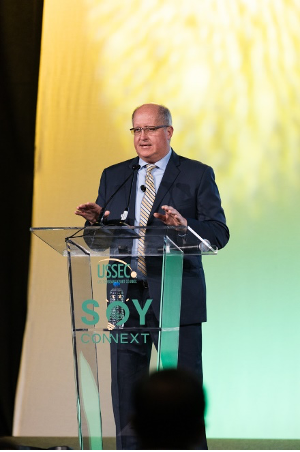Soy Connext Session Explored Supply Shifts
- Category:
- Event followup
- Market Information

By Laura Temple, Communications Consultant, USSEC
Global urbanization, the movement of people to urban areas, is driving the acceleration in trade intensity, Marty Ruikka told Soy Connext attendees. Ruikka, the president of The ProExporter Network, shared predictions about the soy complex based on his economic modeling at the global U.S. Soy summit.

He said about 80 million people are moving to cities each year.
“Urbanization drives demand more than population growth,” he explained. “As people move to cities, they become completely dependent on the global commercial food delivery system. Our model shows that soy production needs to increase about 8 million metric tons per year for stocks to stay even.”
Ruikka believes the U.S. will continue to be a reliable supplier of whole soybeans, soybean meal and soybean oil.
“With more crush capacity, the U.S. may be able to meet increased domestic demand for soybean meal and oil,” Ruikka said. “In fact, the U.S. may even be able to increase meal, as well.”
He added that because of carry markets, the U.S. can export its maximum soybean volume in any given month. This unique characteristic allows the U.S. to effectively respond to global needs.
Ruikka also commented on commodity supercycles: “The last commodity supercycle created the Black Sea export hub, which now accounts for 15% of world trade, and has supported urbanization in the Middle East and North Africa. During the current supercycle, we may be finding a new price plateau for commodities, including soybeans.”
More than 600 members of the soy supply chain from more than 60 countries participated in Soy Connext, the global U.S. Soy summit hosted by the U.S. Soybean Export Council, partially funded by the soy checkoff. The event was held August 22-24 in San Diego, California. Trade teams of international customers visited U.S. Soy farms before and after the event. For more information and other highlights from Soy Connext, visit ussec.org or soyconnext.ussec.org.
This article is partially funded by U.S. Soy farmers, their checkoff and the soy value chain.